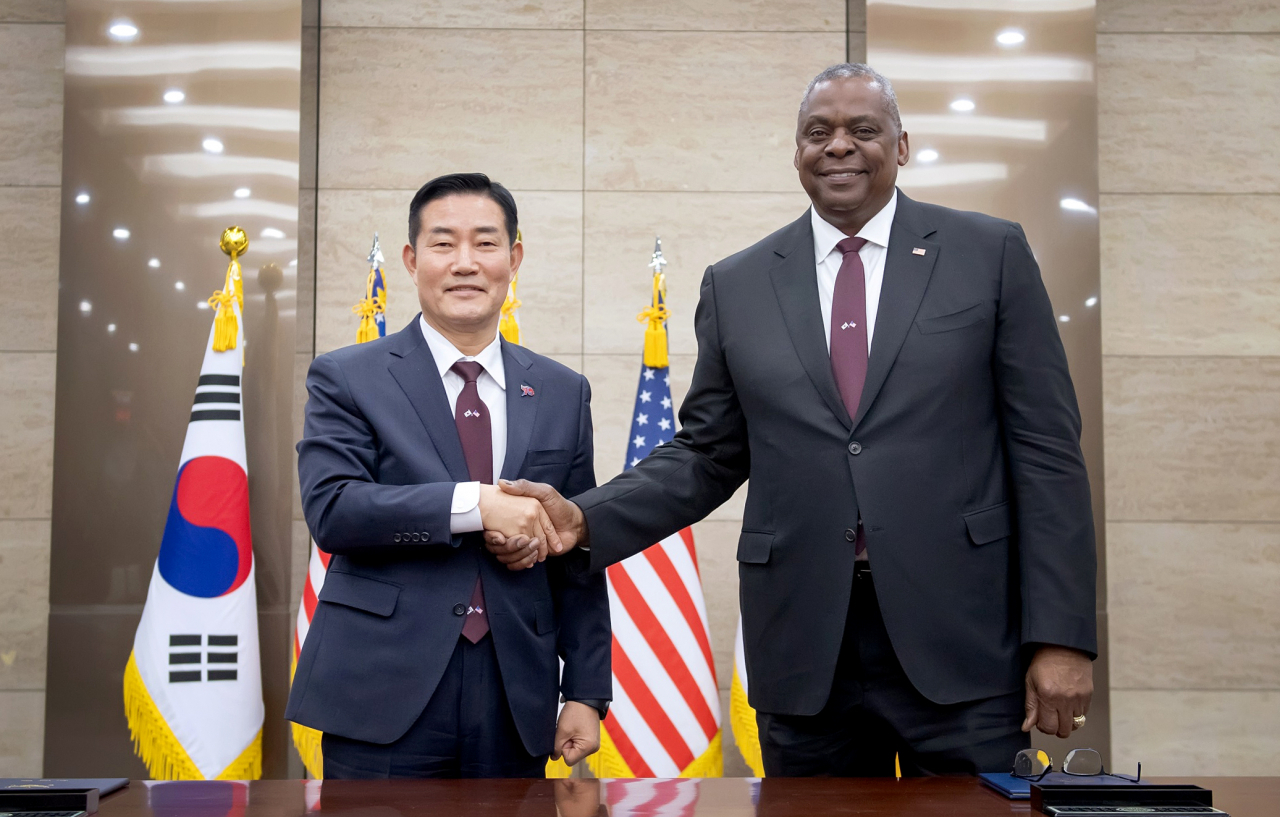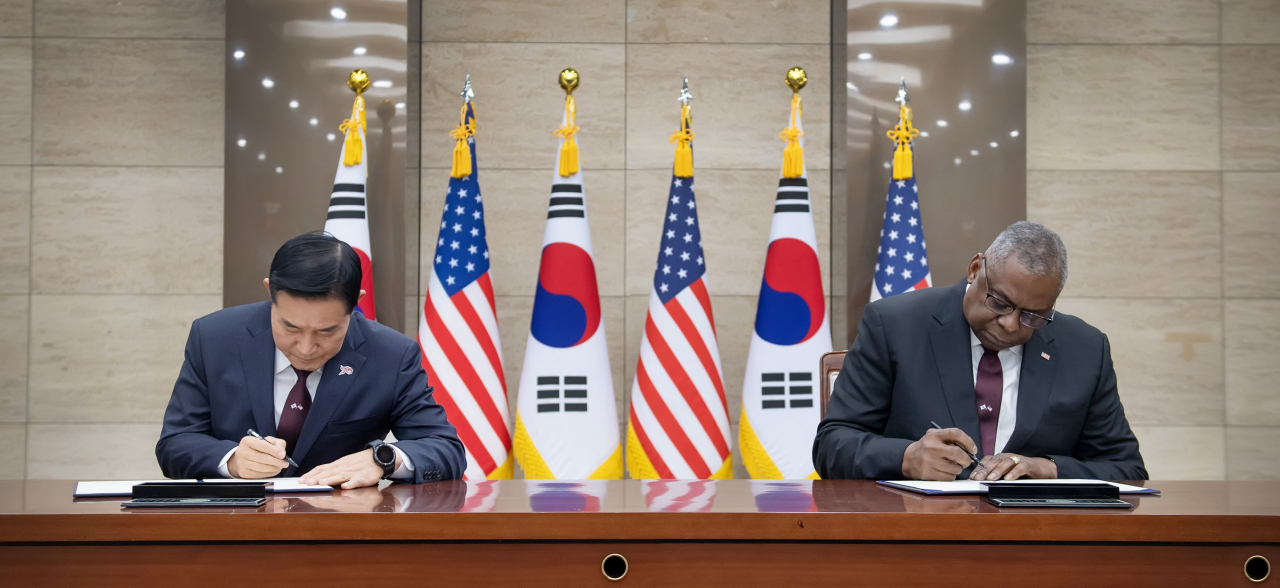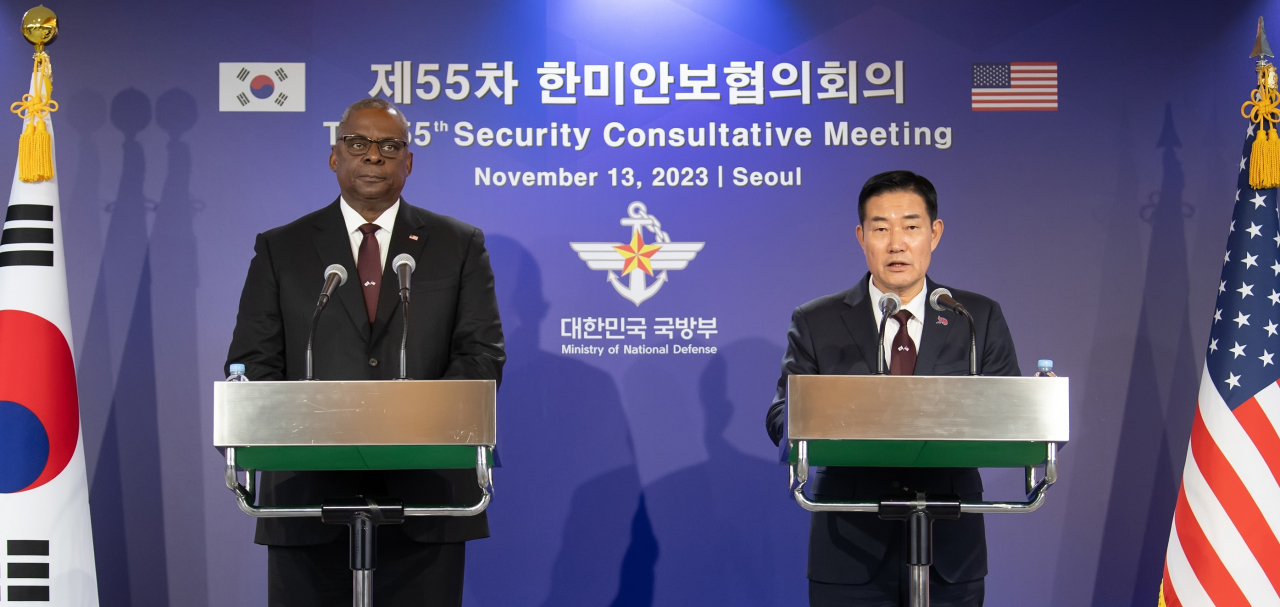S. Korea, US revise deterrence strategy amid growing NK threats
Despite two ongoing wars, Austin reaffirms US commitment to augment deployment of strategic assets in S. Korea
By Ji Da-gyumPublished : Nov. 13, 2023 - 18:11

The defense chiefs of South Korea and the United States on Monday unveiled an updated security strategy, the first in a decade, specifically designed to counter the growing threats emanating from North Korean nuclear weapons and other weapons of mass destruction.
South Korea's newly appointed Defense Minister Shin Won-sik and US Defense Secretary Lloyd Austin announced the completion of revisions to the Tailored Deterrence Strategy, a strategic guideline tailored to threats posed by North Korea.
In December 2021, South Korean and US defense leaders first acknowledged the imperative to amend the TDS, initially crafted in 2013. This recognition stemmed from the rapidly evolving nature of North Korea's missile and nuclear capabilities. The outcome of revising the strategic guidelines came two years after the initial agreement.
"(The defense chiefs) recognized that the 2023 TDS revisions render it into a flexible and robust document that serves as a strategic framework to effectively deter and respond to advancing DPRK nuclear and other WMD and non-nuclear capabilities with strategic impacts," read the joint statement of the annual Security Consultative Meeting, a key bilateral defense dialogue, held in Seoul.
"Also, both (defense) leaders noted that the 2023 TDS reflects guidance on ways to leverage the full range of US military capabilities, including US nuclear capabilities and ROK conventional capabilities, in preparation against DPRK nuclear and other WMD attacks across armistice, crisis, and wartime."
The acronyms ROK and DPRK represent the official names of South Korea and North Korea, which are the Republic of Korea and the Democratic People's Republic of Korea, respectively.

The South Korean Defense Ministry clarified that the 2023 TDS will be pivotal in creating a strong joint defense stance against North Korea's potential deployment of nuclear weapons and other weapons of mass destruction. This strategic plan will be instrumental as the allies incorporate it into their training exercises.
The defense chiefs also adopted the "Defense Vision of the US-ROK Alliance" on the occasion of the 70th anniversary of the alliance that was forged by signing the mutual defense treaty in 1953.
The document reflects the collective vision of the allies in the defense domain, elucidating priorities and development directions for defense cooperation over the next 30 years --strategically aligning with the changing security landscape and aimed at reaching milestones during the 100th anniversary of the alliance, the Defense Ministry said in a separate statement explaining the outcome of the SCM.
"In recognition of the changing security environment, the Alliance must adopt a forward-looking posture that is responsive to its foundational and most pressing threat -- the Democratic People’s Republic of Korea (DPRK) -- while also contributing to the security of the region and the world," the Defense Vision read.
To that end, the document also "reaffirmed the importance of deterring strategic attacks and aggression from hostile actors in the region, including the DPRK, through continued extended deterrence efforts." The allies also expressed their determination to "modernize capabilities to strengthen the combined defense architecture of the Alliance."

During the SCM, the South Korean and US defense chiefs also engaged in discussions on pending matters, including the September 19 inter-Korean military agreement.
Minister Shin views the suspension of this agreement as necessary, stating that it has impeded South Korea's capacity to monitor and conduct reconnaissance over North Korea, leaving the military vulnerable to surprise attacks from North Korea.
However, when questioned about whether the inter-Korean military agreement affected the South Korea-US combined defense posture and if the allies should reassess its effectiveness, Austin chose not to disclose the US position.
"We have an opportunity to exchange views on this and we agreed to stay in close consultation going forward," Austin told reporters at a news conference held at the building of the Defense Ministry following the SCM.
But Austin was confident when asked by The Korea Herald if it is realistic to maintain the current frequency of deployment of US strategic assets, especially amid the ongoing wars in Ukraine and the Middle East.
"The answer is yes. The United States has the most powerful military in the world. Having said that, I'll also say that everywhere we are and everything that we do, we work with allies and partners. That magnifies our strengths," Austin said. "We will continue to stand with our allies and partners in the face of aggression."
The US defense secretary emphasized the fulfillment of the commitment to augment the deployment of strategic assets to the Korean Peninsula, as outlined in the April 26 Washington Declaration. He pointed to significant events such as the entry of the US Navy's nuclear-capable ballistic missile submarine into a South Korean port -- marking the first occurrence since the early 1980s -- and the first-ever landing of the B-52 strategic bomber on a South Korean air base.
"There will be another carrier battle group that comes soon," he said without providing further details on the upcoming entry of the US Navy's aircraft carrier. The US has deployed two aircraft carriers to the eastern Mediterranean following Hamas' attack on Israel on Oct.7.
"So we're going to continue to make sure that this region has what it needs to do, what we and our partners and allies want to do, and that is to maintain a free and open Indo-Pacific region," Austin said.



















